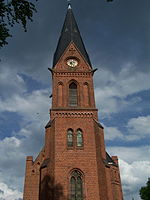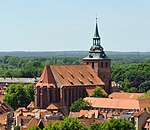List of monasteries and monasteries in the Principality of Lüneburg

The list of monasteries and monasteries in the Principality of Lüneburg lists all monasteries and monasteries in the area of the former Principality of Lüneburg .
The first monasteries were founded in the area of the later Principality of Lüneburg in the 9th century with the St. Michaelis Monastery in Lüneburg and foundations in Bardowick and Ramelsloh. In the following centuries there were further foundings until the founding phase was completed in 1478 with the establishment of a Franciscan monastery in Winsen. At that time there was a total of 15 monasteries in the Principality of Lüneburg : seven male monasteries, six female monasteries and two male monasteries.
In the course of the Reformation , part of the monastery convents was dissolved and the monastery property was confiscated by the dukes of Celle. The canons' monasteries in Bardowick and Ramelsloh remained, as did the monasteries in Lüne , Ebstorf , Isenhagen , Wienhausen , Medingen and Walsrode in the form of evangelical women's monasteries as supply institutions for the daughters of the Lüneburg nobility and the Lüneburg patriciate .
The Michaeliskloster initially continued to exist as a Protestant male monastery and was converted into the Lüneburg Knight Academy in 1655 . While the monasteries in Bardowick and Ramelsloh were abolished in 1850, the six women's monasteries in Lüneburg (also popularly known as Heideklöster ) have existed as Protestant women's monasteries to this day. The monasteries are independent corporations under public law , are maintained by the General Hanover Monastery Fund and are under the supervision of the Hanover Monastery Chamber .
The monasteries partly owned the estate and formed the first curia in the Lüneburg landscape . Up until the 15th century, however, the clergy only played a small part in corporate politics. It was not until the diets in the second half of the 15th century that the prelature appeared as a state with equal rights. The provosts of Medingen, Lüne and Ebstorf as well as the abbots of St. Michaelis in Lüneburg , Oldenstadt and Scharnebeck have participated in the state parliaments since then. However, with the dissolution of part of the convents in the course of the Reformation, the importance of the prelate class again decreased significantly. No representatives of the clergy came to the state parliaments until 1541. Since then, the Abbot of St. Michaelis and delegates from the monasteries in Ramelsloh and Bardowick have represented the clergy.
In addition to the institutions listed here, there were Beguine Convents in Lüneburg and Celle , but they were not actually monasteries.
Monasteries and monasteries in the Principality of Lüneburg
The respective columns can be sorted by clicking the symbol in the table header. The subsection of religious affiliation relates to the time up to the Reformation.
| Monastery (location) |
image | Occupancy | medal | Founded | Dissolved | Remarks |
|---|---|---|---|---|---|---|
|
Ebstorf Monastery ( ) |

|
Convent |
Premonstratensian Benedictines (from 1190) |
1150/1160 | In the course of the Reformation , the provost property was confiscated and the convent was converted into a Protestant women's monastery. This continues to the present day. | |
|
Isenhagen Abbey ( ) |

|
Men 's Monastery Women 's Monastery (from 1262) |
Cistercians | 1243 | In the course of the Reformation, the provost property was confiscated and the convent was converted into a Protestant women's monastery. This continues to the present day. | |
|
Medingen Monastery ( ) |

|
Convent | Cistercians | 1228 | In the course of the Reformation, the provost property was confiscated and the convent was converted into a Protestant women's monastery. This continues to the present day. | |
|
Wienhausen Monastery ( ) |

|
Convent | Cistercians | 1231 | In the course of the Reformation, the provost property was confiscated and the convent was converted into a Protestant women's monastery. This continues to the present day. | |
|
Lüne Monastery ( ) |

|
Convent | Benedictine (from 1272) |
1172 | In the course of the Reformation, the provost property was confiscated and the convent was converted into a Protestant women's monastery. This continues to the present day. | |
|
Walsrode Monastery ( ) |

|
Convent |
The pen was not associated with any order. (although the Rule of St. Benedict was introduced in 1255.) |
before 986 | In the course of the Reformation, the provost property was confiscated and the convent was converted into a Protestant women's monastery. This continues to the present day. | |
| Ramelsloh Abbey ( ) |

|
Male pen | The pen was not associated with any order. | 9th century | 1850/1863 | The pen was repealed in the course of the revolution of 1848 by a state law of 1850. The convention was dissolved in 1863. The former collegiate church is now used by the Ramelsloh parish. |
|
Bardowick Abbey ( ) |

|
Male pen | The pen was not associated with any order. | 9th century | 1850 | The pen was abolished in the course of the revolution of 1848. The former collegiate church is used today by the parish of St. Peter and Paul. |
|
St. Michaelis Monastery ( ) |

|
Men's monastery | Benedictine | before 956 | 1655 | In the course of the Reformation, the monastery was converted into a Protestant male monastery and in 1655 into the Lüneburg Knights' Academy . After the revolution of 1848 it was finally abolished and the monastery property confiscated. The former monastery church is used today by the parish of St. Michaelis. |
|
Oldenstadt Monastery ( ) |

|
Women 's Monastery Male Monastery (from 1133/37) |
Benedictine | before 972 | 1531 | In the course of the Reformation, the convent was abolished under pressure from Duke Ernst the Confessor and the property was confiscated. The former monastery church is now used by the Oldenstadt parish. |
|
Scharnebeck Monastery ( ) |

|
Men's monastery | Cistercians | 1243 | 1531 | In the course of the Reformation, the convent was abolished under pressure from Duke Ernst the Confessor and the property was confiscated. Most of the former monastery church was demolished in the 18th century and a new church building was erected on its foundations. This contains numerous pieces of equipment from the old monastery church and is used today by the parish of St. Marien in Scharnebeck. |
| Heiligenthal Monastery ( ) |

|
Men's monastery | Premonstratensians | 1313 | 1530 | The monastery was moved from Heiligenthal to Lüneburg in 1382 . In the course of the Reformation, the convent was abolished under pressure from Duke Ernst the Confessor and the property was confiscated. The monastery buildings were demolished in the 19th century. |
| Celle Monastery ( ) |

|
Men's monastery | Franciscan | 1452 | 1528 | The convention was abolished in the course of the Reformation under pressure from Duke Ernst the Confessor. The monastery buildings were demolished in the 16th century. |
| Lüneburg Monastery ( ) |

|
Men's monastery | Franciscan | 1235 | 1530 | After the Reformation was implemented in the city of Lüneburg in 1530, the convention was abolished under pressure from the citizens of Lüneburg. The Lüneburg council library is located in the former monastery buildings. |
| Winsen Monastery ( ) |

|
Men's monastery | Franciscan | 1478 | 1528 | The convention was abolished in the course of the Reformation under pressure from Duke Ernst the Confessor. |
literature
- Dieter Brosius : The Lüneburg monasteries in the Reformation. In: Reformation 450 years ago. A memorial from Lüneburg. Museum Association for the Principality of Lüneburg, Lüneburg 1980, pp. 95–113.
- Hans Patze : History of Lower Saxony, Bd.3 / 2, Church and Culture from the Reformation to the beginning of the 19th century. Lax Verlag, Hildesheim 1983, ISBN 3-7848-3425-6 .
- Josef Dolle: Lower Saxony monastery book: Directory of the monasteries, monasteries, commendants and beguinages in Lower Saxony and Bremen from the beginning to 1810, part 1–4. Publishing house for regional history , Bielefeld 2012, ISBN 978-3-89534-956-0 .
Web links
Individual evidence
- ↑ On the founding of the monasteries see: Dieter Brosius : Die Lüneburgischen monasteries in the Reformation in Reformation 450 years ago. A memorial from Lüneburg. Museum Association for the Principality of Lüneburg, Lüneburg 1980, pp. 95–113.
- ↑ For the history of the monasteries during the Reformation see: Dieter Brosius : The Lüneburg monasteries in the Reformation in Reformation 450 years ago. A memorial from Lüneburg. Museum Association for the Principality of Lüneburg, Lüneburg 1980, pp. 95–113.
- ↑ For the current situation of the Heideklöster see: Klosterkammer Hannover. (No longer available online.) Archived from the original on November 22, 2013 ; Retrieved November 4, 2013 .
- ↑ For the Landstandschaft see: Wolf-Nikolaus Schmidt-Salzen: Lüneburg, Fürstentum. In: Brage bei der Wieden (Hrsg.): Handbook of the Lower Saxony Landtag and Estates history. Volume 1: 1500–1806, Hannover 2004, ISBN 3-7752-6016-1 , pp. 135–142 and 349–365, here: p. 356.
- ↑ For the Beguine Convents see: The Lüneburg Monasteries in the Reformation in Reformation 450 years ago. A memorial from Lüneburg. , Museum Association for the Principality of Lüneburg, Lüneburg 1980, pp. 95–113
- ↑ For the Ebstorf monastery see: Josef Dolle: Niedersächsisches Klosterbuch: Directory of the monasteries, monasteries, commendants and beguinages in Lower Saxony and Bremen from the beginnings to 1810, part 1. Verlag für Regionalgeschichte, Bielefeld 2012, ISBN 978-3-89534-956- 0 , pp. 352-360
- ↑ For the Isenhagen Abbey see: Josef Dolle: Niedersächsisches Klosterbuch: Directory of the monasteries, monasteries, comers and beguinages in Lower Saxony and Bremen from the beginnings to 1810, part 2. Verlag für Regionalgeschichte, Bielefeld 2012, ISBN 978-3-89534-956- 0 , pp. 855-862
- ↑ For the Medingen Monastery, see: Josef Dolle: Lower Saxon Monastery Book: Directory of the monasteries, monasteries, commendants and beguinages in Lower Saxony and Bremen from the beginnings to 1810, part 3. Verlag für Regionalgeschichte, Bielefeld 2012, ISBN 978-3-89534-956- 0 , pp. 1044-1050
- ^ For the monastery Wienhausen see: Josef Dolle: Lower Saxon Monastery Book: Directory of the monasteries, monasteries, commendants and beguinages in Lower Saxony and Bremen from the beginnings to 1810, part 3. Verlag für Regionalgeschichte, Bielefeld 2012, ISBN 978-3-89534-956- 0 , pp. 1518-1529
- ↑ For the Lüne monastery see: Josef Dolle: Niedersächsisches Klosterbuch: Directory of the monasteries, monasteries, commendants and beguinages in Lower Saxony and Bremen from the beginnings to 1810, part 2. Verlag für Regionalgeschichte, Bielefeld 2012, ISBN 978-3-89534-956- 0 , pp. 938-947
- ↑ For the Walsrode monastery see: Josef Dolle: Niedersächsisches Klosterbuch: Directory of the monasteries, monasteries, commendants and beguinages in Lower Saxony and Bremen from the beginnings to 1810, part 3. Verlag für Regionalgeschichte, Bielefeld 2012, ISBN 978-3-89534-956- 0 , pp. 1487-1493
- ↑ For the Ramelsloh monastery see: Josef Dolle: Niedersächsisches Klosterbuch: Directory of the monasteries, monasteries, commander and beguinages in Lower Saxony and Bremen from the beginnings to 1810, part 3. Verlag für Regionalgeschichte, Bielefeld 2012, ISBN 978-3-89534-956- 0 , pp. 1271-1278
- ↑ For the Bardowick monastery see: Josef Dolle: Niedersächsisches Klosterbuch: Directory of the monasteries, monasteries, commendants and beguinages in Lower Saxony and Bremen from the beginnings to 1810, part 1. Verlag für Regionalgeschichte, Bielefeld 2012, ISBN 978-3-89534-956- 0 , pp. 34-45
- ↑ For the St. Michaelis monastery see: Josef Dolle: Niedersächsisches Klosterbuch: Directory of the monasteries, monasteries, commendants and beguinages in Lower Saxony and Bremen from the beginnings to 1810, part 2. Verlag für Regionalgeschichte, Bielefeld 2012, ISBN 978-3-89534- 956-0 , pp. 947-960
- ↑ For the Oldenstadt monastery, see: Josef Dolle: Niedersächsisches Klosterbuch: Directory of the monasteries, monasteries, comers and beguinages in Lower Saxony and Bremen from the beginnings to 1810, part 3. Verlag für Regionalgeschichte, Bielefeld 2012, ISBN 978-3-89534-956- 0 , pp. 1136-1140
- ↑ For the Winsen Monastery, see: Josef Dolle: Lower Saxon Monastery Book: Directory of the monasteries, monasteries, comers and beguinages in Lower Saxony and Bremen from the beginnings to 1810, part 3. Verlag für Regionalgeschichte, Bielefeld 2012, ISBN 978-3-89534-956- 0 , pp. 1340-1346
- ↑ For the Heiligenthal monastery see: Josef Dolle: Niedersächsisches Klosterbuch: Directory of the monasteries, monasteries, commendants and beguinages in Lower Saxony and Bremen from the beginnings to 1810, part 2. Verlag für Regionalgeschichte, Bielefeld 2012, ISBN 978-3-89534-956- 0 , pp. 963-968
- ↑ For the monastery of Celle see: Josef Dolle: Niedersächsisches Klosterbuch: Directory of the monasteries, monasteries, comers and beguinages in Lower Saxony and Bremen from the beginnings to 1810, part 1. Verlag für Regionalgeschichte, Bielefeld 2012, ISBN 978-3-89534-956- 0 , pp. 301-303
- ↑ For the Lüneburg monastery see: Josef Dolle: Niedersächsisches Klosterbuch: Directory of the monasteries, monasteries, commendants and beguinages in Lower Saxony and Bremen from the beginnings to 1810, part 2. Verlag für Regionalgeschichte, Bielefeld 2012, ISBN 978-3-89534-956- 0 , pp. 960-963
- ↑ For the Winsen Monastery, see: Josef Dolle: Lower Saxon Monastery Book: Directory of the monasteries, monasteries, comers and beguinages in Lower Saxony and Bremen from the beginnings to 1810, part 3. Verlag für Regionalgeschichte, Bielefeld 2012, ISBN 978-3-89534-956- 0 , pp. 1546-1549